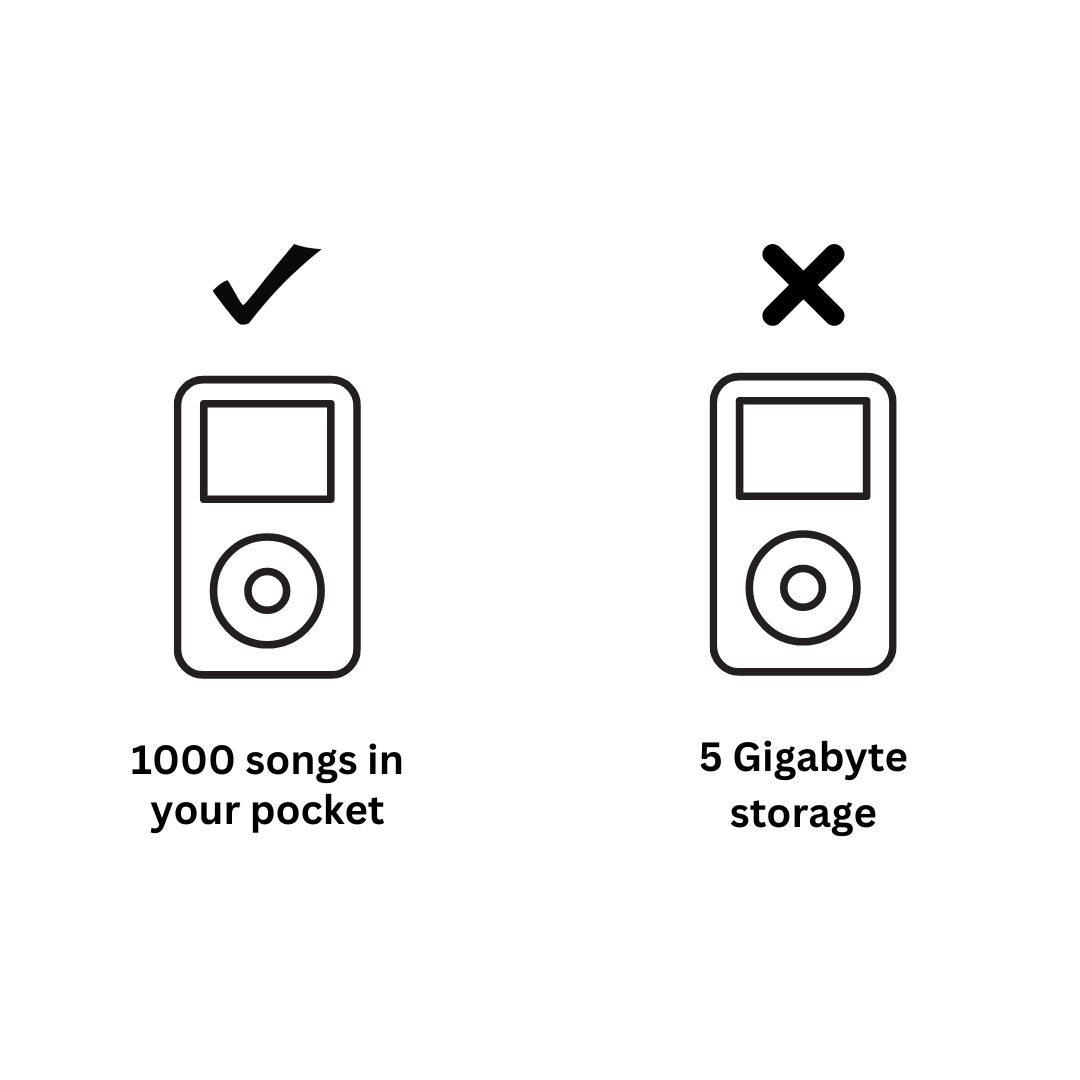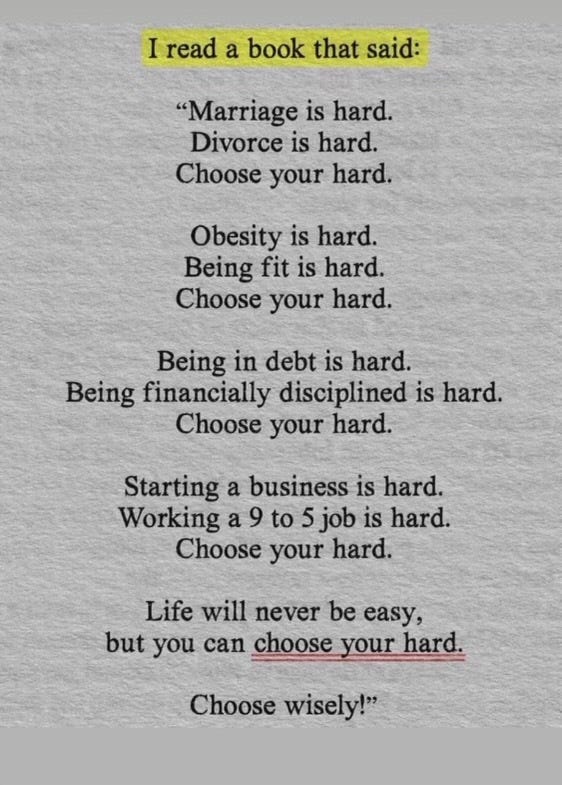My 12 Writing Rules That Helps Me Write Better ✍️
Issue #110: Be a Clear and Confident Writer. Your entire life will change the moment you stop [X] and start [Y]. Choose Your Hard.
Happy Saturday!
I just finished reading Hell Yeah or No by Derek Sivers. It’s a super short read, but really inspiring—especially if, like me, you’re focused on peaceful growth. One of my favorite quotes from the book is: “If you’re more driven than most people, you can do way more than anyone expects.” That one really hit home for me!
Welcome to Learn + Grow, where you will learn tips and tools that will help you be 3% more peaceful + productive in just 3 minutes a week.
💡 Here are 3-ideas to help you learn, grow, and be inspired this week!
🎓 Learn
Writing is a Super Skill
Just like computer skills, writing is a super-skill that helps you succeed in any job or profession.
Think about it: writing is everywhere. Music, movies, websites, sales, marketing, project planning, speeches, presentations—it all starts with writing.
I’m not saying this lightly: getting good at writing skills will improve your odds of success more than any other skill.
For a long time, I didn’t take writing seriously. Because:
A: English isn’t my first language, so I had a bit of anxiety about it.
B: I thought writing was something you’re either born with or you pick up as a kid.
But here’s what I learned:
WRITING IS A SKILL. You don’t “have it”; you learn it.
Over the last two years, I started taking writing more seriously
I spent over $5,000 dollars in learning writing skills.
I built a consistent writing habit, and now I write 4 newsletters: Learn + Grow, Peaceful Growth, WordPress for Enterprises, and M&M (Internal Month in Multidots Newsletter for my team).
I think I’ve written over 150,000 words (almost like writing two Atomic Habits books) in the last 2 years.
What’s crazy is that writing actually energizes me now; it’s not stressful anymore. Writing has helped me connect with my team and even people all over the world.
In this issue, I’ll share a few ‘writing rules' that are sort of my checklist that I follow when I write.
#1: I’ve So Much To Write
Stuck for ideas? Here are some of my go-to prompts to get the creativity flowing:
What are all of the problems I've solved and topics I've learned about in the last 2 years?
Share 1 underrated tip for solving a certain problem.
Share 1 framework that helps you get something done in less time or with less stress.
Share the 1 piece of advice to you would give to a beginner in your field.
Share 1 software tool that helps you the most (that most people know nothing about).
Share a step-by-step guide for accomplishing 1 specific task.
Share the 1 book that most helped you in learning about your topic.
Share the 1 podcast you listen to religiously – and what others will learn from it.
Share 1 mistake you made as a beginner – and what you learned from it.
Share the single most valuable thing you learned from a mentor.
Share your personal story – where you used to be, where you are now, and how you got here.
Share 1 piece of advice to your 5-years-ago self.
Share 1 common trait of the people you look up to.
Share your personal playbook – how you achieved some results and the steps you took to get there.
Share 1 thing you believe that everyone else doesn’t – and why you’re correct
Share 1 (uncommon) observation you have about the world – and why others are missing it
Share 1 razor (decision-making framework) you use in your day-to-day life
#2: Write Drunk, Edit Sober
Starting to write has always been the hardest part for me. I would obsess over a single sentence, stuck for hours trying to make it just right. It was frustrating, slow, and honestly, it took the joy out of writing.
But then I learned something that completely changed my approach: you don’t have to write perfectly, you just have to write. Now, when I sit down to write, I let go of the need for perfection. I write as if I’m “drunk”—I let the words spill out without overthinking or editing along the way. I allow myself to capture whatever comes to mind, even if it’s messy. I’ve realized that the first draft is just about getting ideas out of my head and onto the screen.
The magic happens in the editing. Once everything is written down, that’s when I come back, usually with a fresh perspective, and start refining. That’s where tools like ChatGPT come in handy—it helps me polish my thoughts, clean up my wording, and turn my rough draft into something clearer and more impactful.
Here is the “Drunk” version of the very same paragraph.
“The hardest part for me is getting started with writing. Expecting to write perfect sentences was one of my biggest mistake as writer. I was beating myself if my writing is not good. I’ll stuck in one sentence for hours. It was slow and painful. Now, I write as if I’m drunk-means-I just dump everything that comes out of my chain of conscious memory. And then later, I’ll edit it (using ChatGPT as my assistant) and perfect it.”
💡 Reminder: “Many people are so worried about looking good they never do anything great. Many people are so worried about doing great that they never do anything at all.”
#3: Be Clear, Not Clever
Which headline would you click on?
Clever: Laughing All the Way to the Bank
Clear: How Two Entrepreneurs Turned Their Crazy Idea into a Multimillion-Dollar Business
I used to try to sound clever, but it never really connected with my readers. I realized that simple and clear content is what resonates with people. If people don’t understand what you’re saying, they’ll tune out. The clearer you are, the better chance you have of getting their attention.
Here’s how to keep your writing simple:
✅ Write the way you talk.
✅ Use short, simple sentences.
✅ Cut out unnecessary words.
✅ Use common, everyday language.
✅ Make sure your writing is easy to follow visually.
#4: Make Numbers Meaningful
Don’t just throw out numbers—make them count.
For example:
Instead of saying, “NerdWallet has 20 million monthly visitors,” you could say, “NerdWallet gets 20 times more traffic than Tim Ferriss’s blog.”
It puts things into perspective.
#5: Write in Street Language
Think about your favorite books or newsletters. Chances are, they’re written in the kind of language you use every day. No fancy words, no need for a dictionary. It feels like a real conversation—something you’d hear at home or out on the street. That’s what makes them so easy to connect with.
#6: Try to Answer People’s Questions in Your Content
If you’re writing for your audience, answer their questions. For instance, if you’re writing about real estate, think about questions like:
How do I buy my first rental property?
How do I finance a condo?
How do I remodel a duplex?
#7: Stop Trying to Be Original—Be Specific
The original idea is the end result of being more specific, and more specific, and more specific to the point where my understanding of the topic/problem/solution/story is so incredibly fine-tuned that it’s “different”.
💡Reminder: When you write for everyone, you write for none.
#8: The 4 Types of Topics
I can write a topic in 4 different ways. Decide which one:
Actionable (here’s how) → Example: 20 Productive Things You Can Do in 10 Minutes or Less
Analytical (here’s a breakdown) → Example: 4 Steps to Supercharge Your Weekly Productivity
Aspirational (yes, you can) → Example: Turn Your Desired Behaviors Into Your Default Behavior
Anthropological (here’s why) → Example: 5 Reasons You Should Read Daily
#9: Great Headline Checklist
Here’s a quick checklist for writing headlines:
✅ Clear not Clever: The Power Of Knowing The Odds → The Power Of Knowing The Odds: 4 Keys To Buying Your First Stock
✅ Specify the WHO: How To Get Hired At Coinbase → How To Get Hired As A Project Manager At Coinbase
✅ Specify the WHAT: 4 Things You Should Feel Zero Shame For → 4 Nighttime Habits You Should Feel Zero Shame For
✅ Specify the WHY: 5 Habits Of Financially Smart People → 5 Habits Of Financially Smart People That Unlock Time, Freedom, And 35 Years Of Prosperity
✅ “Twist The Knife” (mean list more problems, benefits, and outcomes in the headline): 5 Reasons Why People Ignore Your Newsletter’s Call To Action → 5 Reasons Why People Ignore Your Newsletter’s Call To Action—And How To Fix It In 30 Seconds
#10: Make Your Audience Picture the Message
When writing, aim to create images in the reader's mind. A great message should be so clear that my audience can picture it instantly.
For example:
"New Balance: Worn by supermodels in London and dads in Ohio."
This paints a vivid contrast that’s easy to visualize and relate to.
#11: The 30-30-40 Rule for Writing Success
Here’s a simple rule to balance my focus on my writing efforts:
30% on writing solid content.
30% on making it look good (formatting, layout). Remember: Most people don’t read; they scan.
40% on sharing it and getting it seen.
So, writing well is just part of the process—I also need to make it easy to read and visible to my audience.
You might be thinking, "Why should I even bother with writing when AI can do it for me?"
Good question. But here’s the thing: AI is just a tool. It lacks creativity, taste, and conviction. Great writing comes from your personal experiences, beliefs, and the ability to surprise your reader.
🚀 Growth Tip
Sahil Bloom shared his reflection on this journaling prompt:
Your entire life will change the moment you stop [X] and start [Y].
I highly recommend that you read and try it yourself this weekend.
Here are my favorites:
Stop relying on motivation and start leveraging discipline.
Stop blaming others for your situation and start taking action to change it.
Stop treating your body like shit and start treating it like a house you have to live in for the next 50 years.
🤩 Inspiration
My wife saw this post on a friend's Instagram and thought it would be a great fit to include here. Reflecting on it, I found it incredibly powerful and inspiring. I hope it resonates with you, too.
👋 Until next time, Anil / CEO and Co-Founder of Multidots, Multicollab, and Dotstore.
FYI…I also write about agency growth and Enterprise WordPress.
May the Peaceful Growth be with you! 🪴
P.S. If you (or someone you know) is interested in sponsoring the Learn + Grow or Peaceful Growth newsletters, just reply to this email and let me know! I’ll be opening up a few sponsorship slots soon.












I couldn’t believe how aligned our thinking is! We both follow a very similar process when it comes to writing. While I may not write as much as you do, adopting this approach has brought me incredible results.
I also want to thank you for inspiring me to dive into reading. I used to think reading was a waste of time, but recently, I finished Surrounded by Narcissists and just started Atomic Habits. I was blown away by the insights, especially how I never realized I was surrounded by toxic people. Your encouragement to read more has truly opened my eyes, and I’m excited to continue this journey of self-improvement.